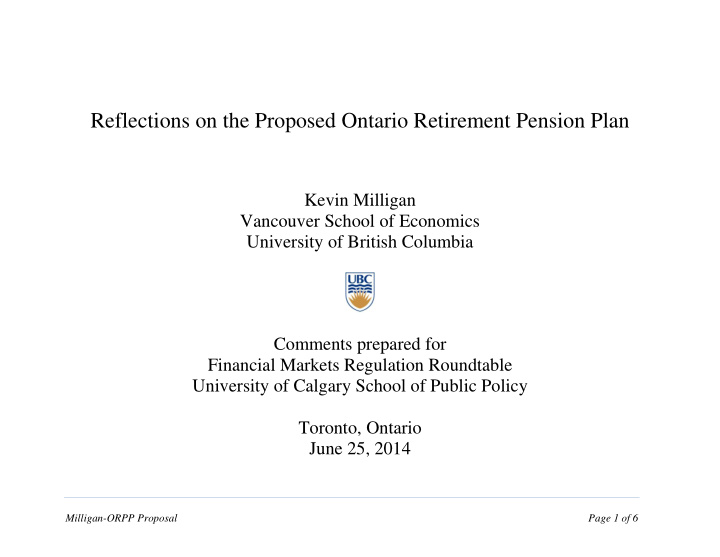



Reflections on the Proposed Ontario Retirement Pension Plan Kevin Milligan Vancouver School of Economics University of British Columbia Comments prepared for Financial Markets Regulation Roundtable University of Calgary School of Public Policy Toronto, Ontario June 25, 2014 Milligan-ORPP Proposal Page 1 of 6
Agenda My thoughts based on work with Tammy Schirle (Laurier) published by University of Calgary School of Public Policy. http://faculty.arts.ubc.ca/kmilligan/research/simulated-cpp-reform.htm Three points to make today: 1. Is there a need for more earnings replacement? 2. Extra coverage to low earners is major design flaw 3. Regulation issues for the ‘O - PPIB’ Milligan-ORPP Proposal Page 2 of 6
Is there a need for ORPP? Many middle and high earners have less than adequate income replacement rates — especially those without employment-based pension. Is that a problem for government to solve? For high earners who don’t save, do we need government to ensure they can holiday in Florence instead of ‘ just ’ Florida? Opinions differ, but here’s mine: Government can provide an inflation-indexed, jointly annuitized, guaranteed benefit at a good price. You can’t buy that on the market— it is good insurance. Some expansion can be justified to firm up the base of retirement income Milligan-ORPP Proposal Page 3 of 6
Replacement Rates Ostrovsky And Schellenberg (2010) Whether couple has pension or not Quintile Neither spouse One or both Lowest Percent with pension 77.3 22.7 Replacement rates: <50 0.8 0.4 50-69 3.7 3.0 70+ 95.6 96.6 2nd Percent with pension 46.7 53.3 Replacement rates: <50 5.5 1.9 50-69 38.9 28.2 70+ 55.6 69.7 3rd Percent with pension 31.0 69.0 Replacement rates: <50 23.9 9.4 50-69 33.0 39.9 70+ 43.2 50.8 4th Percent with pension 22.1 77.9 Replacement rates: <50 27.9 15.8 50-69 26.8 41.2 70+ 45.3 43.0 Highest Percent with pension 23.0 77.0 Replacement rates: <50 38.9 17.8 50-69 23.0 38.3 70+ 37.9 43.9 Notes: For each quintile, the shaded row reports the proportion of couples for which neither has a pension and for which one or both has a pension. Below that, we show the distribution of couples in each quintile across three ranges of replacement rates. The source for all the data appearing here is Ostrovsky and Schellenberg (2010). Milligan-ORPP Proposal Page 4 of 6
Major Design Flaw: Low-Earner Coverage OAS and GIS mean that 95% in lowest earning quintile have >70% replacement rate. 2/3rds have >100%! ORPP makes these low-earners transfer more resources from now to the future. o They are struggling now; they are struggling less in the future. o This is a bad trade. Worse, their contributions are for a full entitlement but they only get half. o Why? GIS claws back half their benefit. o So, they are paying double for a pension they don’t need. Fixes? Exempt low earners. Maybe up to 25K? Milligan-ORPP Proposal Page 5 of 6
Regulation of “ O-PPIB ” Proposal allows opting out for those with “comparable workplace pension”. o So, we w on’t be shifting money out of Teachers or OMERS and i nto ‘ Ontario-PPIB ’ . o Imagine hugeness of CPPIB under a CPP r eform that didn’t carve out existing RPPs. Investment policy: CPPIB has done well here; can ORPP match? o Provincial agreement required for amendments to CPP — hard to put hand in cookie jar. o The platform says both “the ORPP will be publicly administered at arm’s length from government” and that “the ORPP will be able to invest the premiums it collects in Ontario businesses and infrastructure.” Which is true? Milligan-ORPP Proposal Page 6 of 6
Recommend
More recommend